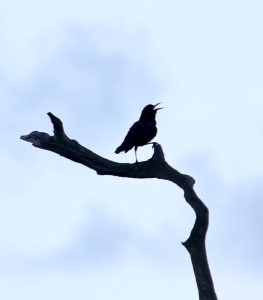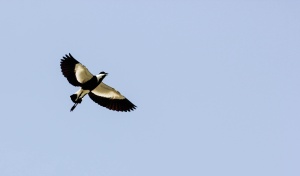In a recent blog post, I mentioned that the name of Zipporah, the wife of Moshe (Moses) is ‘Bird’, in Hebrew. There are often variations in the spelling of Hebrew words transliterated into English, and most often Tzippor (or Zippor) is translated as Bird. Rabbi Natan Slifkin is the author of Nature’s Song (2001), a remarkable book about the beautiful Perek Shira, a small ancient text that I’ve written about before on this blog. I love the beautifully detailed stories about birds that Rabbi Slifkin cites from the Torah, the Talmud, Psalms, and many other sources.
Rabbi Natan Slifkin is the author of Nature’s Song (2001), a remarkable book about the beautiful Perek Shira, a small ancient text that I’ve written about before on this blog. I love the beautifully detailed stories about birds that Rabbi Slifkin cites from the Torah, the Talmud, Psalms, and many other sources.  In this comprehensive commentary, Slifkin has a wonderful chapter titled The Songbird: Spiritual Sensitivity, in which he describes the various meanings of the word tzippor. He begins by stating, “The word tzippor is popularly understood to simply refer to any of the 8,900 bird species.”
In this comprehensive commentary, Slifkin has a wonderful chapter titled The Songbird: Spiritual Sensitivity, in which he describes the various meanings of the word tzippor. He begins by stating, “The word tzippor is popularly understood to simply refer to any of the 8,900 bird species.”
 Slifkin then goes on to teach some of the different perspectives held by great sages in Jewish history as to which birds are referred to by this term. He concludes that tzippor is best translated more specifically as Songbird, the “. . . common name for the zoological category Passeriformes which includes more than 5,200 of the world’s 8,900 species.” (p. 230).
Slifkin then goes on to teach some of the different perspectives held by great sages in Jewish history as to which birds are referred to by this term. He concludes that tzippor is best translated more specifically as Songbird, the “. . . common name for the zoological category Passeriformes which includes more than 5,200 of the world’s 8,900 species.” (p. 230).
Here is another excerpt from the chapter The Songbird: Spiritual Sensitivity: “It is explained that birds have a sixth sense for sanctity. Perhaps this relates to their being creatures especially proficient at shirah [song]. . . . The wings of the bird enable it to leave the ground and ascend to the heavens. In the same way, song enables man to reveal the spiritual roots of his physical world and thereby elevate it Heavenward.” (p.229)
“It is explained that birds have a sixth sense for sanctity. Perhaps this relates to their being creatures especially proficient at shirah [song]. . . . The wings of the bird enable it to leave the ground and ascend to the heavens. In the same way, song enables man to reveal the spiritual roots of his physical world and thereby elevate it Heavenward.” (p.229)
On that note 🎶 ~ SHABBAT SHALOM!


Shabbat Shalom! 🙂
LikeLiked by 1 person
Thanks HJ! Hope you’re having a beautiful weekend.
LikeLiked by 1 person
Beautiful and inspiring!
LikeLiked by 1 person
Thank you so much, Bracha! Your comments are so appreciated.
You – and your entire beautiful family – are an inspiration to me 🙂
LikeLike
I think the translation of songbird is the best. It has a poetic feel and I think birds are poetry in flight and song. Is the a magpie in flight in the last beautiful photo? The bird is stunning.
LikeLiked by 1 person
Hi GWGT…I agree with you about songbirds entirely~!
That bird in flight at the end is not a songbird, I confess, but I like the way it illustrates the quote about birds ascending to the heavens. It’s a Spur-winged Lapwing, an “elegant long-legged plover” (Birds of the Middle East, 2nd Ed, 2010). I saw them frequently in Israel, and spotted this one up north in the Hulah Valley.
LikeLike
maybe it’s the wings that enable it to take flight, but the song enables it to ascend 🙂
LikeLiked by 1 person
What a beautiful thought, Yaffa! I love this~ thanks for sharing it! 😉
LikeLike